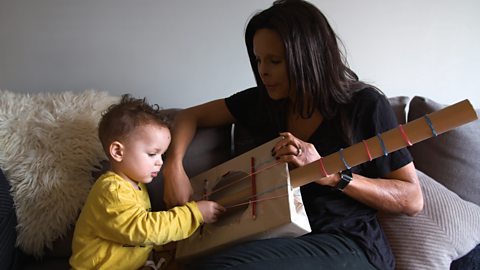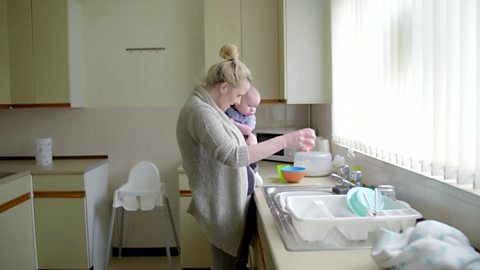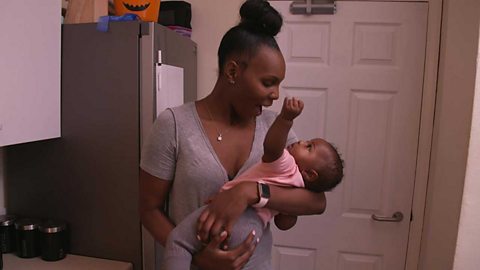You may not realise it, but your home is bursting with exciting musical adventures for your little one.
And you donât need instruments, nor do you even need to be able to sing in tune, explains Music Therapist Ray Travasso. âYou will often hear people say 'Iâm not musical, I canât sing'. Thatâs actually irrelevant. Everyone responds to music. And there are loads of different ways you can enjoy musical experiences at home.â
Make noise with household objects
It doesnât matter what it is, if it makes a noise, itâs an instrument says Ray. âYou canât beat a good old pot and pan bash and the whole family can get involved â all the big music stars probably started out playing them too.â
âAnd you can use water to make noise and play with rhythms too,â recommends Specialist Speech and Language Therapist Alys Mathers. âFill up different containers and pour water in and out of them, or blow across the top.â

Listen and boogie to your favourite hits
âCranking up your music on the radio or your phone will get you dancing and singing, so itâs an easy feel-good activity and also great exercise,â says Ray. Games like musical statues or musical bumps will also help your little one's coordination and listening skills.
You can even play music and sing to baby in the womb, as they start to hear sounds from the outside world at around 15 weeks.
Sing nursery rhymes â and do the actions too
Young children love nursery rhymes â the repetition is great for their language learning and the actions help build their physical skills too. Play around with lyrics and actions for maximum laughs with your little one.

Build DIY instruments
Not only will you have a brilliant sound maker but the creative process of making it together can also spark your childâs imagination. Try a simple rice shaker, a tissue box guitar or even a jam jar xylophone.

Soundtrack daily chores
Yes, you read that right. Even everyday tasks can be opportunities to bond with your little one when add music. Try making up your own songs and rhymes to make routines more fun and get the most out of your one-to-one time. Feeds, nappy changes and bedtimes are all fabulous times to sing.

Use everyday sounds
Build your childâs listening and concentration skills by talking about sounds at home or outdoors. See what grabs their attention and try using your vocal skills (yes, you do have them!) and objects around the house to copy them.
How to make the most of your home jam sessions
- Sit face to face
âMake sure you have lots of eye contact when you sing or make music and itâs a really good idea to dip down to your childâs eye level,â says Alys.
- Follow your childâs lead
âIf they bang three times on a drum, you should bang three times on a drum. If they want to empty a container of water and say âsplashâ, then you do the same â and make it into a splashing song. If they donât want to ping the strings of their cardboard guitar, but bang on it, follow their lead and copy them,â recommends Alys. âThe more you can mirror and copy them, the more they get out of the activity because they can participate and will really listen and focus their attention.â
- Try syllable marking
âThis means taking time to define each syllable in a word like um-brel-la,â says Alys. âUsing a musical object to tap out the syllables of words can help your child build their vocab because it helps them hear the sounds in the words.â
- Get the whole family involved
A rousing singalong or instrument jam are brilliant activities for everyone at home â and over video calls â and can take the pressure off you to be chief entertainer.
- Slow things down
âSlow down songs and rhymes so your child has more time to process them and join in,â says Alys. âThis is much more fun for them than simply watching and listening.â
- Take turns
Singing alternate verses or swapping who has an instrument is great for your childâs language learning. âThis means thereâs an element of turn taking just like verbal conversations and you can stretch your childâs attention span by having slightly longer turns each time,â says Alys.
- Encourage your child
Praising your little oneâs efforts is great for their confidence â so keep encouraging their musicianship.






